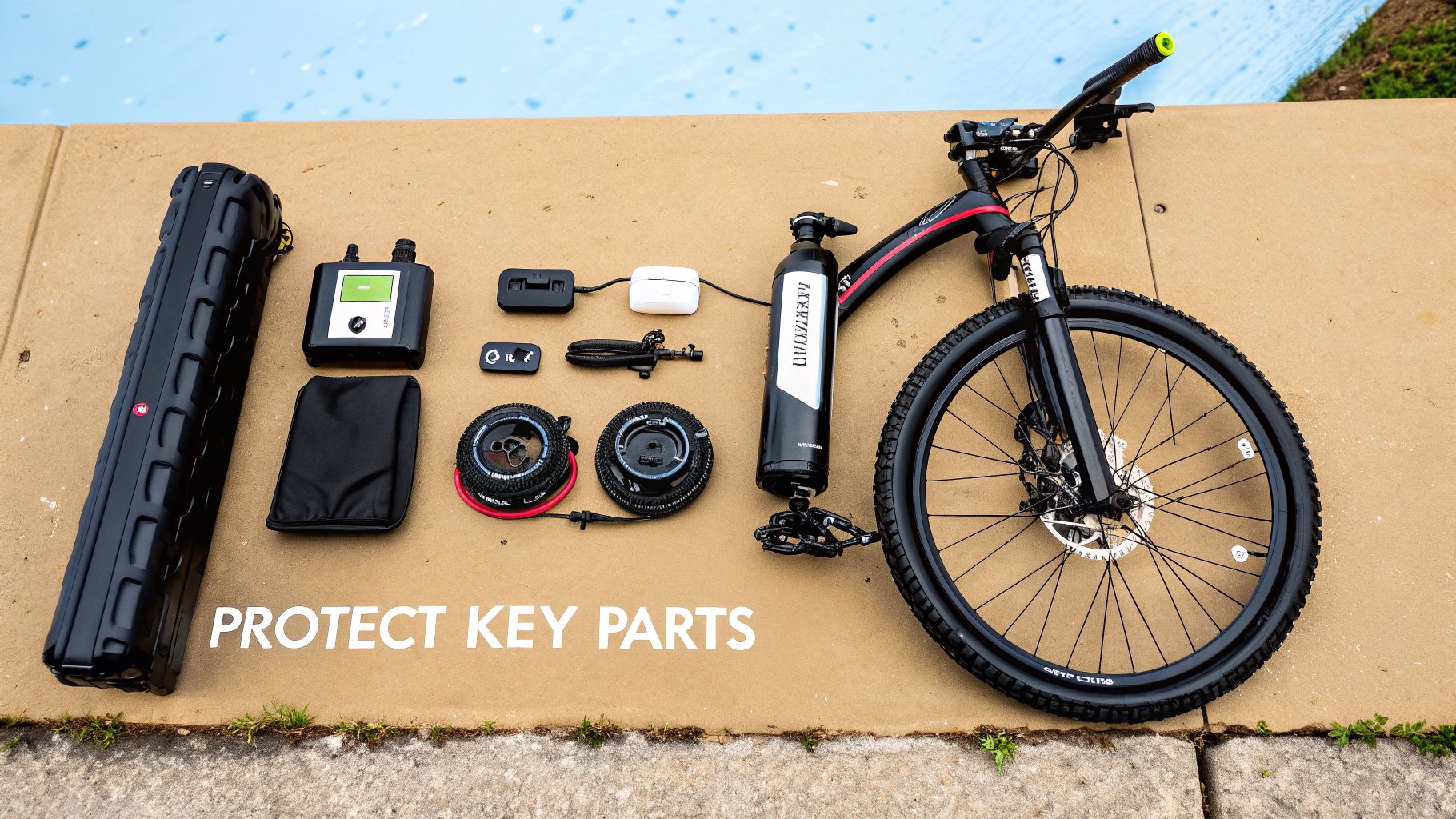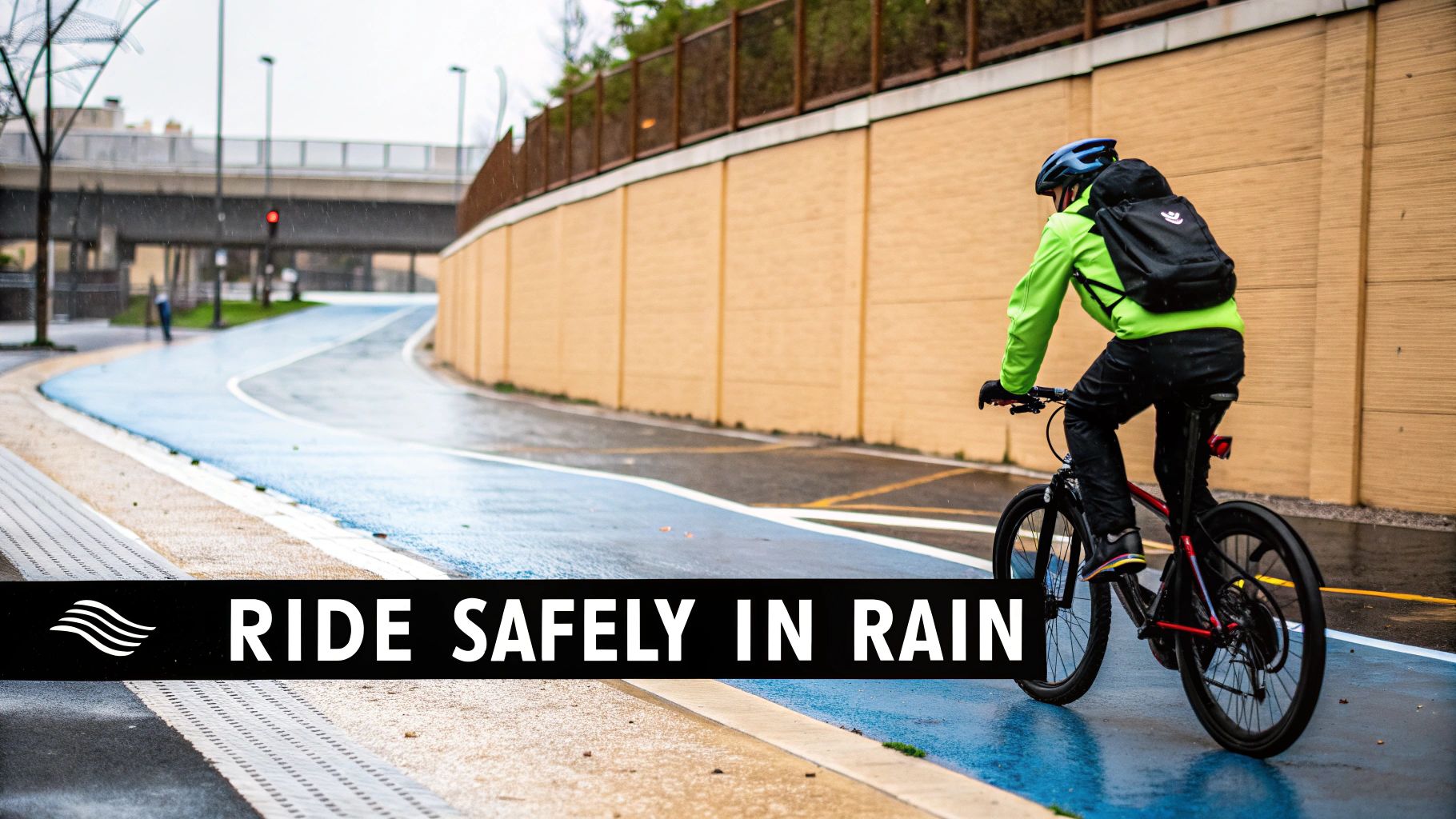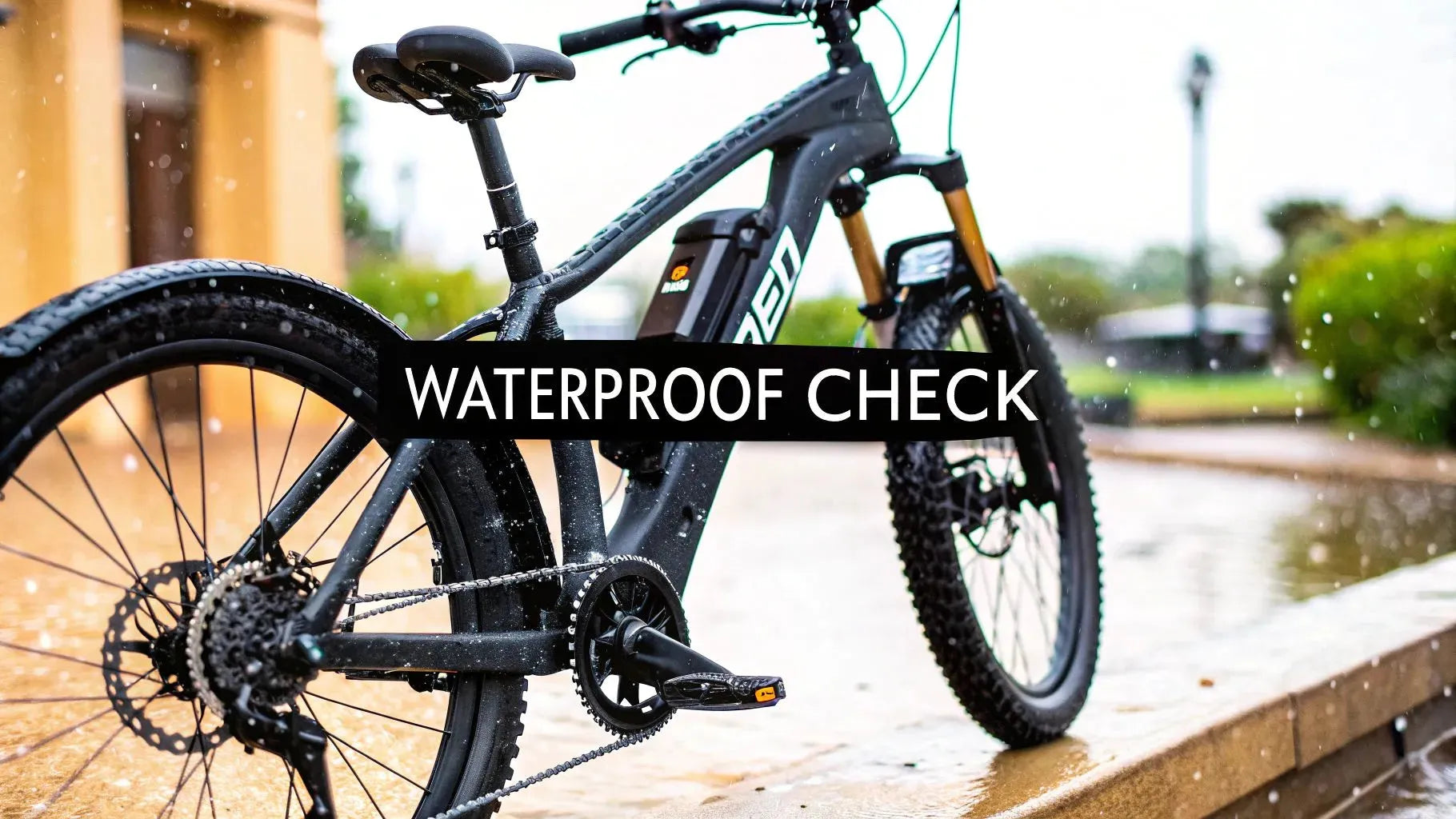So, are electric bikes waterproof? The short answer is a hard no.
Think of it this way: your e-bike is more like a high-quality rain jacket than a deep-sea submarine. It’s built to handle some weather, but it has its limits. This is a really important distinction to grasp, as it means while your bike can likely handle a sudden Florida downpour or a drizzly day in Seattle, you don't want to get caught in a hurricane.
What "Water-Resistant" Actually Means for Your E-Bike
Getting your head around the difference between water-resistant and waterproof is the first step to keeping your e-bike running for years. A truly waterproof gadget can be completely submerged in water and come out just fine. You'd be hard-pressed to find a standard consumer e-bike in the US or Australia that can do that.
Instead, manufacturers aim for water resistance. They design their bikes to shrug off splashes from the road, light rain, and generally damp conditions without giving up the ghost. The critical bits—your battery, motor, and the little display on your handlebars—are sealed up to stop moisture from creeping in on a typical rainy ride home.
But (and it's a big but), they aren't designed to survive a tropical storm, a pressure washer, or being left outside during a massive downpour.
Most e-bikes you'll see on the market in the US and Australia have something called an Ingress Protection (IP) rating. A common one is IPX4, which essentially means it’s protected from water splashing at it from any angle. It's a good baseline, but it's definitely not a free pass to ignore heavy rain. You can get a deeper understanding of e-bike IP ratings and what they mean to see how your own bike stacks up.
The core idea is simple: your e-bike is built to get you home if you're caught in the rain, not for recreational storm-chasing.
To make this crystal clear, here’s a quick breakdown of what you’re dealing with.
Waterproof vs Water-Resistant At a Glance
| Feature | Water-Resistant (Most E-Bikes) | Waterproof (Rare/Specialized) |
|---|---|---|
| Protection Level | Protects against splashes, light rain, and moisture. | Can be fully submerged in water without damage. |
| Real-World Use | Perfect for commuting in a drizzle or on wet roads. | Designed for extreme conditions, like fording streams (uncommon for e-bikes). |
| Sealing | Components are sealed to block moisture entry under normal conditions. | Airtight and watertight seals create an impenetrable barrier. |
| Cleaning Method | Wipe down with a damp cloth. Never use a pressure washer. | Can withstand being hosed down (though still not recommended). |
Basically, one is designed to resist water, while the other is meant to be completely impervious to it.
Key Takeaways for Riders
So, what does this all mean for your day-to-day riding? It's pretty straightforward.
- Light Rain is Okay: Getting caught in a shower or riding on wet roads is what these bikes are built for. No need to panic.
- Avoid Submersion: Steer clear of deep puddles or flooded streets. If the water is high enough to cover the motor or the battery housing, you're asking for trouble.
- No Pressure Washing: This is a big one. The high-pressure stream from a pressure washer can easily blast water past the seals and gaskets, leading to catastrophic electrical failure. Just don't do it.
- Proper Storage is Crucial: Don’t leave your pride and joy out in a relentless downpour. A dry, sheltered spot like a garage or covered patio is always the best place for it.
Decoding E-Bike IP Ratings
Have you ever looked at your e-bike’s spec sheet and seen a code like ‘IPX4’ or ‘IP65’ staring back at you? It might seem like just a bunch of technical nonsense, but that little code is your best friend when it comes to figuring out how much of a soaking your bike can actually take.
This is called the Ingress Protection (IP) rating. It's an international standard used to grade how well an electronic device is sealed against stuff getting inside it—specifically, solids like dust and liquids like water.
What the Numbers Actually Mean
For e-bike riders, the second number is the one that really matters. The first number is for dust protection, and if you see an 'X' (like in IPX4), it just means the bike hasn't been tested for dust. No big deal. Our main concern is water.
So, let's break down the common ratings you'll see on e-bikes.
To make this super clear, here’s a table that translates those IP codes into real-world riding situations.
Common E-Bike IP Ratings Explained
| IP Rating | Protection Level | Real-World Scenario |
|---|---|---|
| IPX4 | Resists splashing water from all angles. | This is your standard for a decent e-bike. You're good to go in a light-to-moderate rain shower. |
| IPX5 | Resists low-pressure water jets. | Think heavier rain and puddle-splashing. This bike can handle a proper downpour without flinching. |
| IPX6 | Resists powerful, high-pressure water jets. | This is serious protection for torrential rain, but it’s still not a green light to blast it with a pressure washer. |
At the end of the day, these ratings give you a solid baseline for what your bike can handle.
A quick heads-up: these ratings come from tests done in a lab. You might see an IPX7 rating on a component, which means it can be dunked in a meter (about 3 feet) of water for 30 minutes. But that doesn't mean your entire bike can go for a swim!
This handy infographic really nails the difference between something that's just water-resistant and something that's genuinely waterproof.

The big takeaway here is that almost every e-bike on the market is "water-resistant," not waterproof. They’re built to shrug off the rain you’ll encounter on a normal ride, but not to be fully submerged. Knowing your bike's IP rating gives you the power to understand its limits before you're caught out in a storm.
Your E-Bike's Most Vulnerable Components
When you’re wondering if your electric bike is waterproof, it's less about the whole bike and more about a few specific, critical parts. Think of it this way: your bike's frame is like a skeleton, built to handle just about anything. But the electrical system? That's the sensitive stuff.

Knowing where the weak spots are helps you ride smarter and keep your bike running smoothly for years. So, when the clouds roll in, these are the parts that need a little extra TLC.
The Big Three: Battery, Motor, and Display
The heart, brain, and dashboard of your e-bike are where water can really cause trouble. Bike makers spend a ton of time and money sealing them up, but no seal is perfect forever.
-
The Battery: This is your bike's fuel tank. It's usually tucked inside a tough plastic or metal case, but the real vulnerability is where the battery connects to the bike's frame. Those little metal contact points are prime real estate for moisture. If water gets in there, it can cause corrosion, mess with performance, and in a worst-case scenario, kill the battery. Looking after your battery is job number one, and we've got a whole guide on extending its lifespan—check out our tips for electric bike battery life here.
-
The Motor: Whether it’s a hub motor in your wheel or a mid-drive motor at the cranks, it's built to be tough. But "tough" doesn't mean "invincible." The seals and gaskets that keep water out can only handle so much. Hitting a deep puddle at speed can force water past those defenses, especially on older bikes where the seals might be a bit worn. This is exactly why you should never, ever submerge your e-bike.
-
The Handlebar Display: Your little command center is designed to handle a downpour, but it's not a submarine. It's got buttons and seams, and during a serious deluge, a tiny bit of moisture can find its way inside and wreak havoc on the electronics.
Here’s the key takeaway: The seals and casings on your e-bike's electronics are like a high-quality raincoat. They’re fantastic for keeping you dry in a storm, but they are not a deep-sea diving suit.
It’s not just about the big components, either. Don't forget about the network of electrical connectors and wiring that snakes through your bike's frame. If these connections stay damp ride after ride, corrosion is almost inevitable. A simple wipe-down after riding in the rain can make a huge difference.
So, Why Aren't E-Bikes Fully Waterproof?
It’s a fair question. If everyone wants an e-bike that can shrug off the rain, why don't manufacturers just build them like submarines? It all comes down to a classic balancing act: performance vs. price vs. what riders actually need.
Getting to a truly waterproof rating, like IPX7 (which means it can be submerged in water), would demand a huge overhaul in engineering and materials. We're talking heavy-duty, airtight seals on every single part—the battery case, the motor, every last cable connection.
That kind of fortress-like protection would make e-bikes a lot heavier and, more importantly, way more expensive. The global e-bike market is exploding—it's expected to be worth around USD 113.64 billion by 2030—because people want reliable daily transport, not an amphibious assault vehicle. In both the US and Australia, the focus is on building bikes that can handle everyday weather without breaking the bank. You can read more about the rapid growth of the e-bike market if you're curious.
The Real-World Trade-Offs
Let's be honest: most of us aren't fording rivers on our commute. We're dealing with downpours, puddles, and damp roads. E-bike manufacturers know this, so they design for the 95% of situations people actually find themselves in, not the extreme 5%. It’s a smart approach that keeps the bikes affordable and practical for the vast majority of riders.
The decision to make e-bikes water-resistant instead of waterproof is a deliberate one. It’s a calculated trade-off that gives you solid performance for typical weather without the massive cost of full waterproofing.
Interestingly, we have the rugged world of shared e-scooters to thank for some improvements. Those things are left out in all weather and have to be tough as nails. The push to make them more durable has led to better, more weather-sealed components, and that tech is slowly making its way into the e-bikes we buy. So, while your bike might not be ready for a swim, its weather protection is getting better all the time.
How to Safely Ride Your E-Bike in the Rain

So, your e-bike is water-resistant. That's great! But knowing that and actually feeling confident riding through a downpour are two very different things.
Getting caught in the rain doesn't have to spell disaster for your bike. If you just get a simple game plan down for before, during, and after your wet ride, you can seriously extend the life of your e-bike’s most important (and expensive) parts.
Before you even roll out the door, just give your bike a quick check. Is the battery locked in tight? Is the connection port clean and dry? A secure fit is your best friend when it comes to keeping water out of the electronics.
Once you're out there, how you ride makes a big difference. Take it easy—wet pavement is slick, and you'll need way more room to stop. But the biggest rule of all? Avoid deep puddles at all costs. Seriously. Dunking your motor hub or battery case, even for a second, is just asking for a bad day. Treat big puddles like they're landmines for your bike's electrical system and just steer around them.
Your Post-Ride Checklist For a Healthy E-Bike
The moment you get back home is crucial. What you do in the next few minutes can mean the difference between a happy e-bike and a very expensive repair bill. This isn't just about wiping it down; it's about protecting the heart of your ride.
Make this routine a habit—no excuses.
- Kill the Power: First thing's first, turn the entire system off.
- Dry Everything: Grab a soft, absorbent towel and give the whole bike a thorough wipe-down. Pay special attention to the battery case, motor, display, and especially the electrical contact points.
- Pull the Battery: If your battery is removable, take it out. Carefully dry the terminals on the battery and the contacts on the bike's frame. Let it all air dry completely before you even think about putting it back in or plugging it in to charge.
Here's the cardinal sin of e-bike care: never, ever use a pressure washer. That high-pressure spray will blast water right past the seals and straight into your motor and battery. It's the fastest way to cause catastrophic damage. A damp cloth is all you need.
A little bit of gear can go a long way, too. Investing in a good set of fenders is one of the smartest upgrades you can make. They'll keep you a lot drier, sure, but they also stop that gritty, grimy road spray from constantly sandblasting your bike's sensitive components. For more ideas, check out our guide to the best electric bike accessories.
Got Questions About E-Bikes and Water? We've Got Answers.
Even after all the tech talk, you probably still have a few burning questions about what to do when your e-bike meets a downpour. Let's run through some of the most common things riders ask.
Can I Just Hose My Electric Bike Down?
You can, but you have to be careful. Think "gentle shower," not "fire hose." A light spray from a regular garden hose is usually okay to get the worst of the mud off.
The golden rule is to avoid high pressure. Seriously, never point a pressure washer or a high-pressure nozzle at your e-bike. That kind of force will blast water right past the seals and straight into your motor, battery connections, or display. Your safest option is still the classic bucket of soapy water and a sponge, followed by a light rinse.
Help! My E-Bike Went for a Swim. What Now?
Okay, first—don't panic. If your bike ends up submerged in a massive puddle or a flooded street, what you do next is critical.
First and most importantly, do not turn it on. Kill the power immediately by removing the battery. Then, carefully tilt the bike every which way to drain as much water as you can from the frame and motor housing. Get it inside to a dry, warm place and let it air out for at least 48 to 72 hours. But before you even dream of putting that battery back in, get it to a certified e-bike mechanic for a proper inspection.
A professional check-up after a bike goes underwater is a must. You can't see the slow, creeping corrosion that can fry your electronics from the inside out, but a good mechanic can.
Will Riding in the Rain Kill My Warranty?
This is a big one, and the answer is usually no. For most e-bikes sold in the US and Australia, manufacturers expect you to get caught in the rain. Riding in normal wet weather will not void your warranty.
Where you'll get into trouble is if the damage comes from misuse. Things that will almost definitely void your warranty include:
- Blasting it with a pressure washer.
- Dunking the bike completely in water.
- Leaving it outside to be battered by storms day after day.
Taking good care of your bike after a wet ride is key. If you want to keep it in prime condition for the long haul, check out our guide on electric bike storage solutions for some great tips on keeping it safe and dry.
At Punk Ride, we stock a huge range of electric bikes built tough enough for real-world riding. Check out our collection and find a ride that can handle your all-weather adventures at https://www.punkride.com.





Share:
Are Electric Scooters Street Legal? A Global Guide
Your Guide to Electric Bicycle for Delivery Success